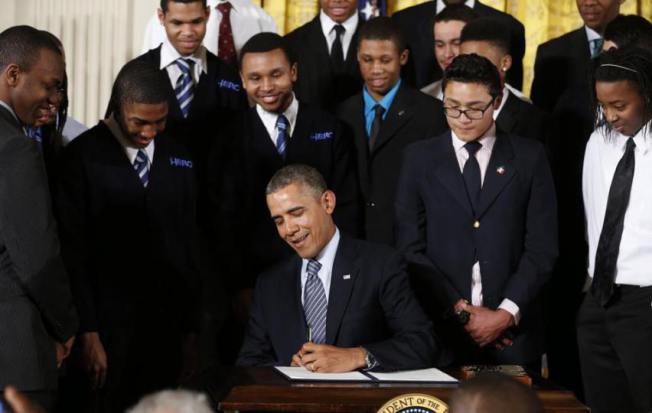
For young minority men, equal opportunity needed
Consistent with his State of the Union pledge to use the “pen or the phone” to advance his priorities, in late February President Obama announced a White House-led initiative to address the needs of boys and young men of color. The president understands that improving life outcomes for young minority men and boys is important for them and their families, and vital to the nation’s security and prosperity. The question before the country is whether, nearly 150 years after the constitutional embrace of African Americans into the bosom of American family and society, we can shift our collective view of young minority men and boys from being a “problem” to being assets and talent the nation needs.
The White House announcement builds upon years of efforts by scholars, community groups, think tanks, and philanthropic organizations to call attention to the plight of young minority men, who are more likely than their white peers to drop out of school, experience a disproportionate burden of health risks and health problems, suffer unemployment, and fall into the juvenile and criminal justice systems. Nearly a decade ago, the Dellums Commission (named for former congressman and Oakland mayor Ronald V. Dellums and organized by the Dr. Gail Christopher, formerly of the Joint Center for Political and Economic Studies in Washington), sought to identify and offer strategies to address the multiple challenges faced by young men and boys of color. Its summary report, “A Way Out,” noted that the challenges these young men face are often the result not only of neglect and marginalization, but also of bad policy.
Many of the barriers facing men and boys of color are rooted in residential segregation, a problem that has eased nationwide but that nevertheless persists at high levels. Several U.S. cities, including Detroit, Milwaukee, Chicago, and Newark, have levels of segregation only slightly lower than what existed in apartheid-era South Africa. Segregation concentrates poverty by excluding and isolating people of color from the mainstream resources – health care, high-quality schools, investment capital, access to good jobs – that are needed for success, and it plays a significant role in the racial wealth gap: Homes owned in segregated communities don’t appreciate at the same rates as homes in majority-white communities, and they were more likely to have been lost to their owners as a result of the subprime and predatory lending crisis.
The Dellums Commission noted that these trends “perpetuat(e) a matrix of exclusion.” Despite similar rates of drug use among white, black, Native American, and Latino youth, law enforcement is more likely to target young men of color, who then go on to face a juvenile and criminal justice system in which their outcomes at every step are demonstrably worse than for their white peers, even controlling for the type of offense and court history. Young men of color are more likely than whites to be expelled from school as a result of “zero tolerance” disciplinary policies, and black job applicants with no criminal record have a harder time getting a callback for a job than white job applicants who do have criminal records.
How significant is the impact of this marginalization for economic potential and productivity in the United States? Given that more than two of five boys under age 18 living in the United States are a racial minority, and that minority men will soon constitute a majority of the male workforce, the risk of maintaining the status quo is huge. States are beginning to recognize that years of over-investment in prisons and criminal justice, with typically accompanying reductions in education and health care, have led to dead ends for too many men who, with appropriate prevention and diversion services, could otherwise be productive contributors to society.
The Dellums Commission offered an array of solutions to these barriers, many of which have been considered and implemented in communities around the country. For example, noting the high proportion of boys and men of color who display symptoms of trauma as a result of exposure to violence in schools, homes, and neighborhoods, the commission called for greater local, state, and federal investments in prevention and treatment for mental health problems, as well as pretrial diversion and treatment-focused sentencing for non-violent drug offenders.
A White House-led initiative has the potential to effect broader change. Using the pen and the phone, President Obama can encourage employers to “ban the box,” that is, eliminate questions about prior felony convictions for job applicants. The president can call out negative media portrayals of young men of color and encourage more balanced and nuanced treatment. He can challenge societal expectations of young men of color, as he has done by noting how his upbringing benefited from growing up in a highly diverse, pluralistic community.
The White House initiative falls short of actual legislation, but it has the potential to move the ball forward on one of the nation’s most vexing challenges – how to value people who for decade after decade have been denied an equal chance to pursue their ambitions, and who have everything to offer to solve the nation’s challenges.
Brian Smedley, PhD., is the Vice President and Director of the Joint Center’s Health Policy Institute

